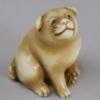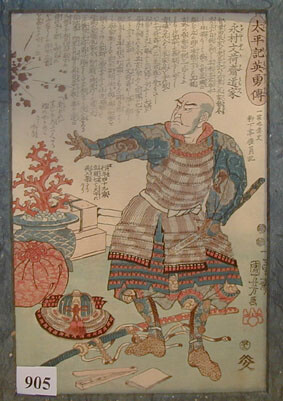-
Posts
341 -
Joined
-
Last visited
-
Days Won
2
Content Type
Profiles
Forums
Events
Store
Downloads
Gallery
Everything posted by leo
-
Hi, as I read it, the length of the blade is 1 shaku, 3 sun, 2 bu, which adds to about 40cm. On the photo the blade looks longer to me The blade which looks pretty, is unokubi zukuri(naginata naoshi) which is a style often used for swords in the Nanbokucho and Oei period and again in the 19th cent. If it is Koto, it is in exceptionally good condition! If Koto, it might be a shortened naginata, but with the yokote I think it is rather a sword! There were plenty of Kaneharu 兼春 in Muromachi era, some in Shinto and one around 1870 according to Hawley. For somebody holding the blade in his hands, it should be possible to tell the appr. date of manufacture. Regards,
-
The bohi not only added beauty to a blade and reduced weight. If done properly, it even increased the structural stability of the blade at the same time. Physically this effect is achieved by enlarging the surface of the material. It is the same principle as in a steel double-T-girder which provides much more structural stability for a building than a solid beam would. If you see the section of a ji with double bohi you will see a pretty massive double-t-girder. As Jim stated, this was well known in most cultures who made edged weapons, even though I do not support the bloodgroove theory: I´ve been hunting deer and wild boar all my life and stuck my knives(no grooves) into a lot of living and dead flesh, so personally I cannot confirm this "sucking" theory. Apart from that, a human torso, which should be the primary target for a lethal thrust, consists of more cavities, soft organs and liquid carrying vessels than solid muscle! (The bodybuilders among you are exempted
-
Dear Vlad, for info, see here: http://www.nihontocraft.com/japanese_sw ... s.html#top It is normal, that the name of the person who submitted an item to shinsa, is put down in the paper, but for privacy the name of the former owner is usually covered, when the paper is shown publicly! Regards,
-
Hello, Scott, here are some examples. On Japanese Auction pages you will find plenty of variations, old and new. http://page22.auctions.yahoo.co.jp/jp/auction/l62631748 http://page19.auctions.yahoo.co.jp/jp/a ... x184110174 http://page7.auctions.yahoo.co.jp/jp/auction/g106168861 http://page5.auctions.yahoo.co.jp/jp/auction/e102660091
-
Hello, Peter, it may be the pictures, which trick me, but except for the leather cover it does not look Japanese to me! Regards, Martin
-
Thanks for the link, Adam, supports my opinion on the value! Apart from the nakago, I find this sword not so attractive plus its only a wakizashi and its a later gen. I wonder how much Choshuya would ask for the a.m. katana if it had TH papers, 3 maybe 4 Million?
-
Adam, you are mistaking the belly of the dragon for the upper leg of no.3. Actually this leg is hidden behind the torso. The arrangement of legs is correct!
-
Hey Alan, If I am not mistaken, this is what I said. Cheers,
-
Actually I find this inscription very interesting. As Peter mentioned, there are several Amahide blades on the net carrying this "ordered by Suzuki" remark. Considered how few showa blades survived action during and after the war, there must have been hundreds of blades originally, made to order of this ominous Master Suzuki. So imho this guy surely was not the owner of a fencing school, but rather a wholesaler or a high ranking civil servant, supplying the military with ordnance material! Also, if these orders from Amahide were large, it is likely that most of them were mass produced. Does anybody know more about this type of mei?
-
Basically, yes. Usually this happens when the blade straightens itself due to(unwanted) stress relief. I am not a swordsmith, so the metalurgists and professionals among you may correct me. I try to say it the way I understand the process: When a blade is tempered (yaki-ire), the blade bends upward and a lot of structural stress is built up. This is usually relieved afterwards by a low- temperature heat treatment(yaki-modoshi). If this is not done accurately or not at all, there will remain unhealthy tension. Depending whether this is towards yakiba or towards mune, there will be hagire or shinae. Unfortunately these not always appear immediately, because then the blade would be scrapped. To the shock of us poor collectors these cracks usually show after centuries of use and repeated polishings, when the thickness is reduced and the structure thus weakened.
-

Help with a date or place or time
leo replied to Kanjisan's topic in General Nihonto Related Discussion
Also, according to Wikipedia, there is an Azuchi-Momoyama period which lasted from 1573 to 1606. So the date on your sword seems ok, provided it is genuine. -

Help with a date or place or time
leo replied to Kanjisan's topic in General Nihonto Related Discussion
That is probably correct, Allan. What I have read, it is an area near Lake Biwa. -

Help with a date or place or time
leo replied to Kanjisan's topic in General Nihonto Related Discussion
Allan, you can easily google Azuchi and Momoyama and what it historically means. In this case Azuchi is probably Azuchi Castle which was Oda Nobunagas castle and oite means "at" or "in". -
Grey, I have to back Brian in this. From my experience, especially here in Europe, the price difference between a unpapered gimei blade and one with NBTHK papers, signed (in this case even dated) by a rare artist, is huge!! Even if the quality of workmanship is outrageous, nobody will take the risk of spending a larger amount of money on an unpapered and possibly gimei blade. So we are talking about 5.000,- max. for the unpapered variety. A signed and dated Norimitsu II or III of this quality, provided the polish is very good, would probably fetch 15 to 20.000,-! But as Jacques pointed out, the chance of it getting a paper is very slim! I checked my pretty big library and could not find a single oshigata of a Norimitsu working around this date! Still, attending a stateside Shinsa would be worth the money!
-
According to the date 1396 and the signature, it could be Norimitsu III. This guy is mentioned in the books, but I could not find an 3rd gen. oshigata to compare the kanji. I could only find oshigata of 1st gen. and then from 4th gen. upward. Does anybody has a scan of 3rd gen.? Curtis, I hope you have a recent NBTHK paper going with this blade or even the 10.000,- will remain a dream. If not, why not submit it?
-
Let´see, lots of loose hada indeed points to late Muromachi. On the other hand clumsy nakago hints at late 19th or even 20th c. But if o-suriage the nakago could even have been changed in Shinto times by somebody not so professional. So sugata and kasane would give it away: Elegant shape and thin to medium kasane would make it a o-suriage koto blade. If the kasane is thick and the sugata unshapely as the nakago, it is very late! Regards
-
Hi folks, as this discussion involves a lot of individual interpretation anyway and is getting a bit cramped now and then, I would like to hear your opininon on the following: Years ago I aquired a nice woodblock-print by Kuniyoshi depicting Nakamura Bunkasai(Heroic Stories of the Taiheki). The picture description by the auction house was: "Samurai in full armour, on the ground his helmet and tachi-sword" Now after all the input accompanying this thread, I am contemplating sending them a request to strictly change their descriptons in the future: "......., on the ground his helmet and tachi-sword, which might contain a katana-blade"!!! :lol: What do you think? (Not too serious)comments welcome,
-
to supplement Moritas post: Katabami is "creeping woodsorrel" which looks like cloverleaf, but is a weed poisonous to cattle
-
Well Chris, guess this happens. did not see it in time either. At least it was a fair and professional judgement so no harm done to anybody!
-
Eric, You cannot tell a tachi blade from a katana blade if it has no signature! You can only draw conclusions. If you have a long early koto blade which is unsigned and suriage, it is always safe to assume it is a tachi and was originally worn as one. Theoretically any loose blade of any age without a signature could have been within a tachi koshirae but later blades were more likely mounted as katana. Blades with tachi signature are tachi with the exception of most Hizen katana which were signed tachi style! Primarily the definition whether tachi or katana is a matter of the koshirae: swords are commonly described as tachi if they are mounted as one and are worn cutting edge down. The pictured sword from the bay: Koshirae dubious, if Japanese at all. the pictures of the blade are insufficient. If somebody buys it like that he would be better off buying lottery tickets! Regards
-
Dear Petter, these are probably the Kanji: 寿命 This school was active during Koto and Shinto times, mainly in Mino, but also in other provinces. The nakago looks late Koto or early Shinto. Pictures of the blade are essential though, to determine school and age. Regards
-
Morita San, just read that you stated, Kanematsu is the family name. So its not 2 smiths, but a family name which sounds like a first name? Regards,
-
DrJoe, please leave a name after the message, so you can be properly addressed. See here: http://home.earthlink.net/~ttstein/kanetats.jpg Morita San, you were faster with the translation! The signature implicates that it is a joint work of 2 smiths. In this case it is doubtful because the blade is non-traditionally made and looks oil-quenched. Members more experienced with Showa smiths can maybe tell you more about these smiths. I only know them because many years ago I owned a gendaito blade made by them. Regards,
-
Hallo Guido, impressive and very decorative painting. I could find 2 paintings by Kumon Kikusen. I included their signatures: "Kikusen" + personal seal. I have to confess that I am not an expert on paintings either. Maybe he signed differently on kakemono? Grüße,
-

New to this board and seek expert's advice on tadatsuna
leo replied to orange's topic in Auctions and Online Sales or Sellers
Hi, Karl! Chris is right! About a great smith as this specific Tadatsuna you will find enough info on the web to do some initial research, the results of which you can then discuss here. This spares the members the feeling just being used as an inexpensive information bureau! Does the blade have papers by NBTHK or NTHK? I assume it does not. The likelihood of it being a gimei signature then is very high! Best Regards,




